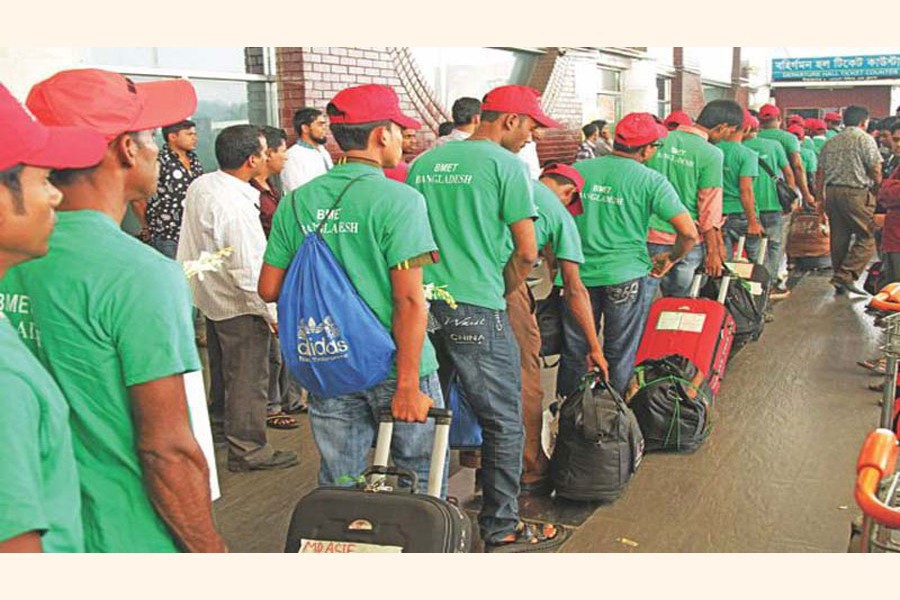
Migration as reported in Bangladesh media is all about bringing home dollars. Since dollars went short remittance is what it's all about. However, there is a global cloud hanging over migration as many countries are becoming less interested in the type of migrants produced by Bangladesh.
Migration is created by economic demand but natural disaster as well. The recent addition of climate change has begun to power more migration as livelihoods are lost. It's not just internal but even external migration too as the affected sell land cheaply to fund migration abroad. Often, it doesn't work causing one disaster after another.
Social, political and cultural distress also continues to cause migration. Many move to neighboring countries where they feel more included. Hindus in West Bengal and CHT groups in Myanmar are two such examples. Meanwhile, Rohingyas are a good example of such migration to Bangladesh.
SEVERAL KINDS OF MIGRANTS
The high failure rate of migration in Bangladesh should cause more concern. In general, migrants can be split as successful, failed and intending migrants.
Successful Migrants are able to organize funds to go abroad, find quality work for long enough time to pay off debts and remit enough funds to significantly enhance their economic base at home.
Failed Migrants are of two types. a. Those who fail to migrate after spending partial funds for their migration or fall victim to fraudulence. b. Those that migrate but fail to find quality work or work long enough to pay off their debts and are forced to return home within a short period.
Failed Migrants are about roughly about 30% of the total migrant population but accurate data on pre-flight failed migrants is limited. That means the percentage of failed migrants could be even higher.
Intending Migrants are those who are in the process of migration at different stages of preparation. Few surveys have been done on the percentage of people who wish to migrate to various destinations based on socio economic indicators.
CHANGING DIRECTIONS?
Broadly they are for major migrant destinations. a. Middle East. b. Europe. c. South East Asia. d. North America. However, the Middle East is the largest destination headed by Saudi Arabia but increasingly people are looking for other destinations in the zone. South East Asia destinations are led by Malaysia, Singapore and Korea mostly. South Korea is processed by BOESEL who train them in skills and language making them more stable migrants than others.
Europe intending migrants are both regular and irregular types. The latter are likely to take very high risks to reach there. Recent experience of the Romanian embassy in Dhaka which faced a huge number of applicants but many/most left Romania for Europe showcases the problem.
North American and Canadian migration is considered the highest destination level but problems have recently begun to emerge. Several cases of migrants particularly in the student category with fake visas or admission certificates have been sent back. 700 Indians with fake papers were recently sent back from Canada.
FORMAL AND INFORMAL MIGRATION GOVERNANCE
The Migration Governance Framework was produced jointly by the IOM and the Government of Bangladesh (2017) to manage the sector better. Its main objective was to strengthen the capacity of the GOB in migration management and policy development. Although the situation has improved in the last five years as per field reports particularly in case of decentralization, a situation of concern remains with the failed migration issue.
In fact this sector has grown a great deal pushed by misreading of demand and weak management of economic migration scenarios. Lesser demand of non- skilled workers and inadequate capacity building of intending migrants are two reasons for this. Informal facilitators -dalals- who can be both professional and relatives of intending migrants can make more money by luring people there than by doing years of work. Hence failed migrants are increasing.
Several donors and GOB have begun rehabilitation projects of returnee migrants (read failed) but this skill development should have happened before and not after returning. Better information is available now but not good enough as the number of intending migrants is so high. One needs to recognize and deal with the informal sector migration players too which has not happened.
The dangers in the migration process are increasing. IOM newsletter - 13/6/23- says, "Our data shows that 92 percent of people dying on this (Afro-ME ) route remain unidentified," said Koko Warner, Director of the Global Data Institute hosting the MMP. "The tragic loss of life on dangerous migration routes highlights the importance of data and analysis in driving action."
In Bangladesh, the focus has largely been on how much they remit. Safe migration is a need, not a choice, as a global clampdown on all kinds of migration may happen and that means Bangladesh's dollar income will decline. It's therefore in everyone's interest to get migration governance running hard in every space within Bangladesh to ensure sustainable income in this sector.
afsan.c@gmail.com
© 2026 - All Rights with The Financial Express
